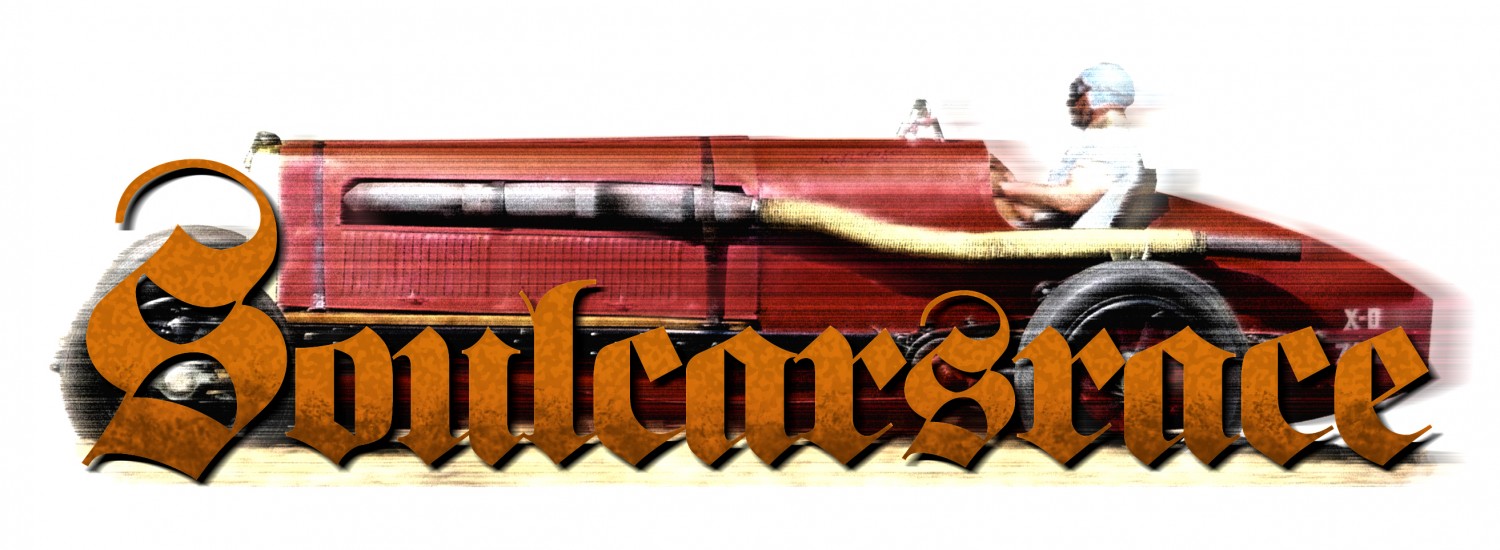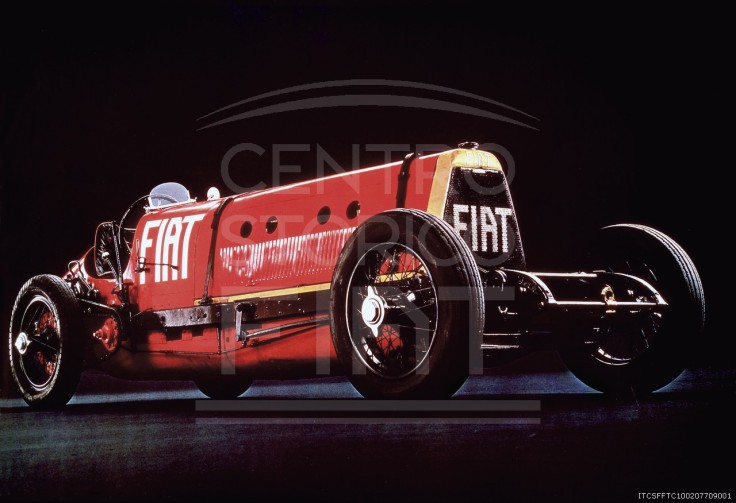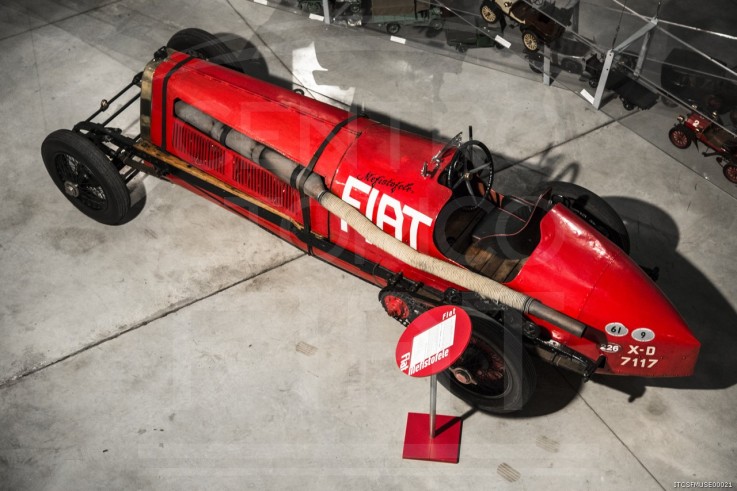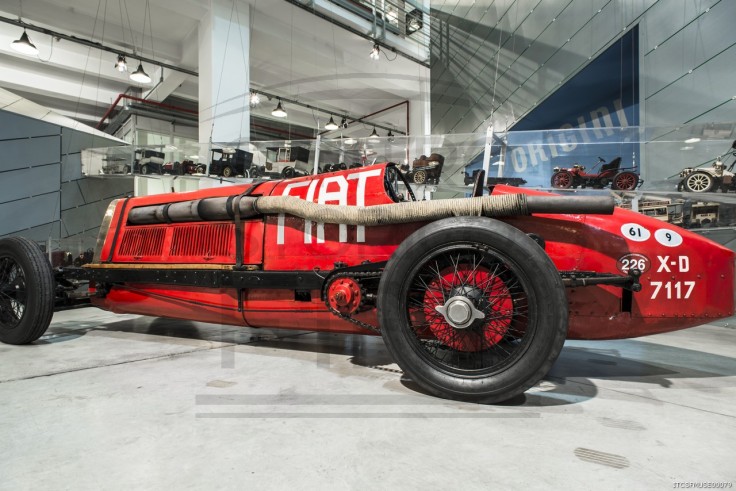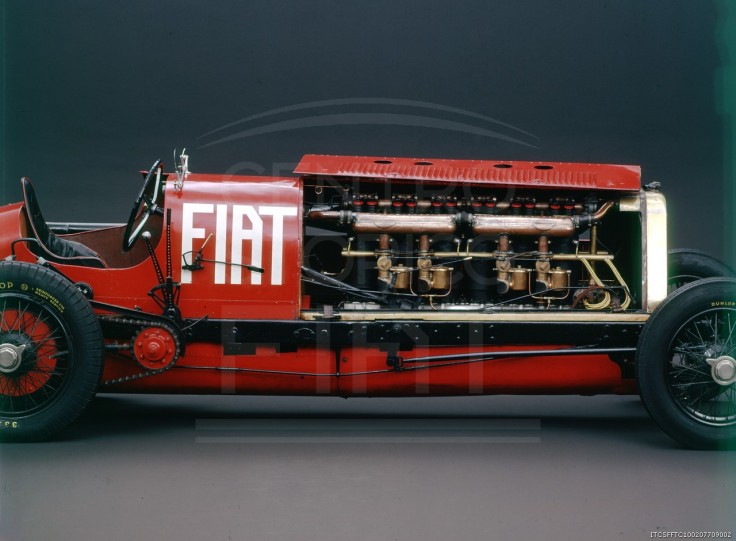Storia della FIAT Mefistofele/The story of the FIAT Mefistofele
Il modo in cui la FIAT NB-4 Mefistofele è nata, rappresenta molto bene il desiderio di sfidare il futuro tipico dei primi decenni del secolo. Una sfida carica di creatività, sperimentazioni pioneristiche, velocità, pericoli spesso sottostimati o per niente valutati e tanta polvere ingoiata. Questo è anche lo spirito di Soulcarsrace, che nel proprio logo ha deciso di raffigurare la FIAT Mefistofele.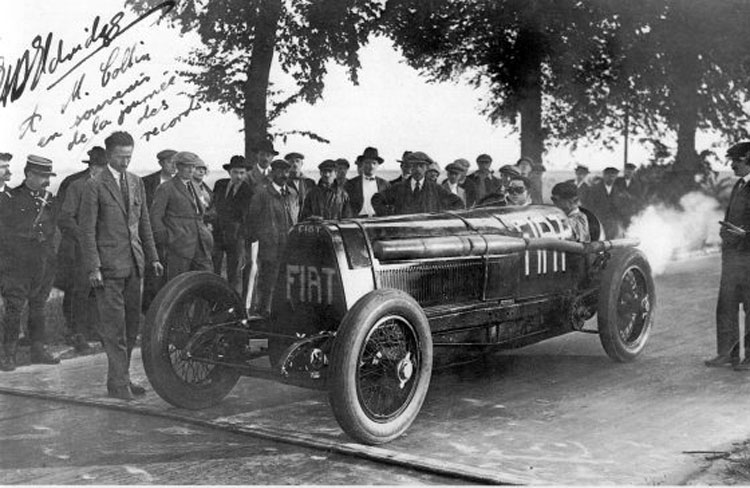 Immagine: 12 luglio 1924, la FIAT Mefistofele taglia vittoriosa il traguardo ad Arpajon. Cartolina autografa di Sir Ernest A.D. Eldridge – Autore sconosciuto – Image: July 12, 1924, the FIAT Mefistofele victorious the goal size to Arpajon. Autograph card of Sir Ernest A. D. Eldridge – author unknown
Immagine: 12 luglio 1924, la FIAT Mefistofele taglia vittoriosa il traguardo ad Arpajon. Cartolina autografa di Sir Ernest A.D. Eldridge – Autore sconosciuto – Image: July 12, 1924, the FIAT Mefistofele victorious the goal size to Arpajon. Autograph card of Sir Ernest A. D. Eldridge – author unknown
Prequel: 1908, Circuito di Brooklands
Prima di raccontare la storia della Mefistofele, è necessario tornare al 1908. Il pilota australiano Selwyn Francis Edge, trasferito in Inghilterra, vincitore nel 1903 della Gordon Bennet race su una Napier, all’epoca aveva lanciato la seguente sfida: “Nessuna auto a 4 cilindri è in grado di battere la mia Napier!!”. Felice Nazzaro[1], pilota e meccanico presso la FIAT (fondata 9 anni prima), era riuscito a convincere l’azienda, che raccogliere questa sfida avrebbe significato una pubblicità molto efficace. Il luogo della competizione, sarebbe stato il velocissimo Circuito di Brooklands, da poco ultimato, le cui curve sopraelevate erano state progettate e calcolate per poter essere percorse a qualsiasi velocità. Alla FIAT si partì subito con lo studio dell’auto, dato che vi erano solo 6 mesi di tempo. Il risultato fu una 200 HP (ma alcuni riportano 175 HP), nella quale Nazzaro aveva inserito un ingegnoso sistema per impedire il surriscaldamento dei pneumatici, grazie a dei getti d’acqua posizionati sopra alle ruote posteriori.
Immagine: Francis Selwyn Edge, pilota da record, con la sua auto Napier sei cilindri al Circuito di Brooklands, 1907 circa. (Foto di Popperfoto/GettyImages) – Image: Selwyn Francis Edge, record-breaking racing driver, with his six-cylinder Napier car at Brooklands Racing Circuit, circa 1907. (Photo by Popperfoto/Getty Images)
Embed from Getty ImagesImmagine: Selwyn Francis Edge su Napier, Gordon Bennett Race, 1903. La Gordon Bennett Race era un evento organizzato da James Gordon Bennett, proprietario dell’Herald newspaper di New York per promuovere l’industria automobilistica. La prima gara si tenne tra Parigi e Lione nel 1900, ma nel 1903 la gara si svolse per la prima volta, in un vero circuito presso Athy in Irlanda. Grazie alla Gordon Bennett Race nasce il concetto di Gran Premio di automobilismo. Nella competizione del 1903, Selwyn Francis Edge veniva squalificato per essere stato aiutato a partire con una spinta. (Foto di National Motor Museum/patrimonio immagini/Getty Images) – Image: Selwyn Francis Edge in a Napier, 1903 Gordon Bennett race. The Gordon Bennett Races were organised by James Gordon Bennett, proprietor of the New York Herald newspaper to help promote the motor industry. The first race was held between Paris and Lyon in 1900, but in 1903 the race was staged on a circuit for the first time, at Athy in Ireland. The Gordon Bennett Races are regarded as the birth of the idea of Grand Prix motor racing. Selwyn Francis Edge was disqualified from the 1903 race for receiving a push start. (Photo by National Motor Museum/Heritage Images/Getty Images)
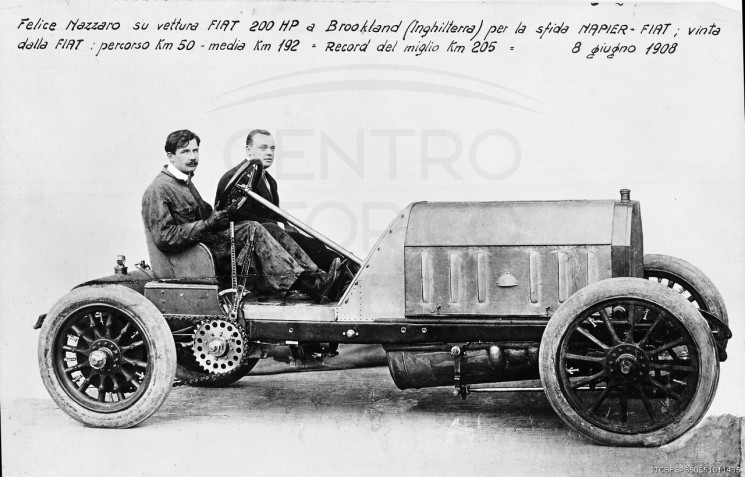 Immagine: Felice Nazzaro a bordo della FIAT 200 HP a Brooklands – 8 giugno 1908 (Archivio e Centro Storico Fiat – FCA Group) – Image: Felice Nazzaro‘s FIAT on board 200 HP at Brooklands-June 8, 1908(archives and historic Fiat – FCA Group)
Immagine: Felice Nazzaro a bordo della FIAT 200 HP a Brooklands – 8 giugno 1908 (Archivio e Centro Storico Fiat – FCA Group) – Image: Felice Nazzaro‘s FIAT on board 200 HP at Brooklands-June 8, 1908(archives and historic Fiat – FCA Group)
Giugno 1908, Circuito di Brooklands.
Le auto dovevano compiere dieci giri (circa 45 km). La sfida prese il via: alla partenza, la Napier di Edge staccò da subito la FIAT di Nazzaro, che dopo 3 kilometri, con il motore entrato a pieno regime, l’aveva già raggiunta. Al terzo giro la Napier fuse il motore. L’auto di Nazzaro continuava costante verso la vittoria, ma negli ultimi giri un uccello si schiantò, prima contro il volante per poi rimbalzare sul viso di Nazzaro, che stava correndo ad una velocità sicuramente superiore ai 200 km/h. Per un attimo Nazzaro perse il controllo della sua FIAT, che iniziò a sbandare, ma che grazie alle sue grandi doti di pilota, riuscì a mantenere in pista fino alla fine. Tagliò vittorioso il traguardo ad una media di 192 km/h. e con il viso completamente insanguinato. Felice Nazzaro fu il primo uomo a superare i 200 km/h su un automobile.
1922, Circuito di Brooklands
14 anni dopo, stesso luogo. Il pilota canadese John Francis Duff che correva già da qualche anno su questo circuito con una FIAT S.61, stava cercando un auto più potente per gareggiare. Acquistata una FIAT NB-4 (o SB-4), forse la stessa di Nazzaro, aveva provveduto a potenziarla ulteriormente, inserendo pistoni in alluminio e aumentando il rapporto di compressione. Durante una delle gare che si svolgevano frequentemente a Brooklands, probabilmente a causa di questa esasperazione nel potenziamento del motore, uno dei due blocchi di cilindri esplose. Numerosi pezzi metallici vennero sparati verso il cielo, sfiorando la testa di Duff e portando con se una parte del cofano. Ricadendo in pista provocarono uno dei più grandi disastri mai registrati nella storia dell’automobilismo sportivo. Duff, miracolosamente scampato alla morte, abbandonò l’idea di correre con quest’auto, per avviare invece una collaborazione con Bentley, che aveva in quel momento come principale obbiettivo l’ingresso agonistico a Le Mans [2].
Immagine: Agosto 1922, un radiocronista, con un ingegnoso marchingegno commenta la corsa all’Autodromo di Brooklands. (Foto di topico Ufficio Stampa/Getty Images) – Image: August 1922, a commentator with an ingenious gimmick comment theBrooklands race track rush. (Photo by topical press agency/Getty Images)
Embed from Getty ImagesImmagine: Alcune spettatrici si rilassano sotto al sole all’Autodromo di Brooklands. (Foto di topico Ufficio Stampa/Getty Images) – Image: Spectators at Brooklands motor-racing track, Surrey, relaxing in the sunshine. (Photo by Topical Press Agency/Getty Images)
Nascita di un mostro
Sir Ernest A.D. Eldridge [5], era un pilota e nobile londinese, non nuovo alla creazione di mutazioni “in stile Frankestein”, nate dall’accoppiamento tra auto e velivoli. L’automobile, (se così si può chiamare), con la quale correva all’epoca, era una Isotta-Fraschini del 1907 di cui aveva mantenuto lo chassis, e sul quale aveva installato un motore aeronautico Isotta-Maybach da 20.500 di cilindrata. Un mezzo che faceva pur sempre un certo effetto, pur trattandosi di un epoca, nella quale la gente era oramai abituata a vedere viaggiare veicoli, tra i più disparati. Eldridge decise di acquistare i resti della FIAT NB-4 di Duff, oramai in disuso dopo il terribile incidente di Brooklands, per affrontare una grossa sfida: correre per battere il record di velocità terrestre. Con lo sviluppo rapido della industria automobilistica, i primati di velocità erano diventati oramai quasi un ossessione, sia per i privati che per le case automobilistiche, che oramai da tempo, avevano intuito quanto tali vittorie fossero un sistema di promozione pubblicitaria molto efficace. A tale scopo Sir Ernest decise di sostituire il vecchio motore FIAT, con un motore che avesse perlomeno la potenza della Isotta-Maybach che era abituato a guidare in pista.
Immagine: Ottobre 1922, Ernest Eldridge al volante della Maybach con motore Isotta Fraschini, mentre tenta di superare Thomas al volante di una Leyland Eight a Brooklands, Surrey. (Foto di topico Ufficio Stampa/Getty Images) – Image: October 1922, the driver Eldridge in the Maybach engined Isotta Fraschini, attempting to pass Thomas in the Leyland Eight at Brooklands, Surrey. (Photo by Topical Press Agency/Getty Images)
Acquistò quindi un motore aeronautico FIAT A12 bis che normalmente veniva impiegato sui biplani da ricognizione come il FIAT R2, il 7B1 S.I.A, piuttosto che sul bombardiere Caproni Ca. 46. Si trattava di un motore a 6 cilindri raffreddato ad acqua, da 21.706 cc. con una potenza di 260 cavalli. Per poterlo alloggiare sullo chassis della FIAT NB-4, avendo grosso modo il doppio delle dimensioni di quello precedente, Edlridge dovette necessariamente allungare il telaio della NB-4, e a tale scopo impiegò parti dello chassis di un bus londinese. La trasmissione a catena venne mantenuta, ma decise di apportare alcune modifiche, inserendo 4 valvole per ogni cilindro, candele Magneti Marelli, due carburatori e aumentando così la potenza fino a 320 cv, con 1800 giri e un rapporto di compressione di 5 a 1.
6 luglio 1924: la sfida per il record mondiale di velocità
Siamo ad Arpajon, una piccola cittadina a 35 kilometri a sud di Parigi. Mentre le famiglie si recano alla messa domenicale, il nobile britannico Sir Ernest A.D. Eldridge e il pilota francese René Thomas[3], si danno appuntamento per sfidarsi in Route d’Orléans, una stretta via alberata. E’ il giorno della battaglia. In palio c’è il titolo di automobile e uomo più veloci al mondo. Il primo a bordo della sua FIAT NB-4 completamente trasformata, il secondo al volante di una Delage La Torpille V12.
Embed from Getty Images
Immagine: due delle illustrazioni realizzate da Piet Olyslager tra il 1960 e il 1963 per “The BP Book of World Land Speed Records”, pubblicato da Herbert Jenkins, Londra, 1963. LaDelage V12 di Renè Thomas e la Fiat Mefistofele, 1924 (foto di Museo della scienza/SSPL/Getty Images) – Image: two of a series of illustrations produced by Piet Olyslager between 1960 and 1963 for “The BP Book of World Land Speed Records”, published by Herbert Jenkins, London, 1963. The Delage V12 driven by Renè Thomas and the Fiat “Mephistopheles” 1924 (Photo by Science Museum/SSPL/Getty Images).
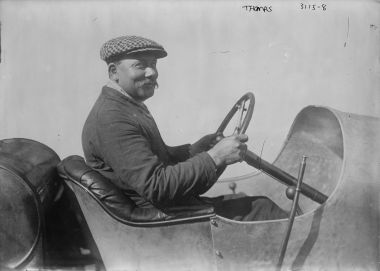
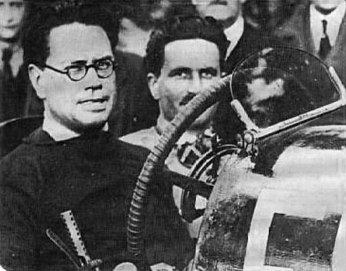 Immagini: a sinistra René Thomas alla 500 miglia di Indianapolis, sabato 30 maggio1914 – United States Library of Congress’s Prints and Photographs Division Washington, D.C. 20540 USA under the digital IDggbain.16384. A destra: Ernest Eldridge alla guida della sua FIAT Mefistofele ad Arpajon, Francia. Autore sconosciuto. – Image: left, René Thomas at the Indianapolis 500 on Saturday, May 30, 1914 – Image: United States Library of Congress’s Prints and Photographs Division Washington, D.C. 20540 USA under the digital IDggbain.16384. Right, Ernest Eldridge driving his FIAT Mephistopheles in Arpajon, France. Author unknown.
Immagini: a sinistra René Thomas alla 500 miglia di Indianapolis, sabato 30 maggio1914 – United States Library of Congress’s Prints and Photographs Division Washington, D.C. 20540 USA under the digital IDggbain.16384. A destra: Ernest Eldridge alla guida della sua FIAT Mefistofele ad Arpajon, Francia. Autore sconosciuto. – Image: left, René Thomas at the Indianapolis 500 on Saturday, May 30, 1914 – Image: United States Library of Congress’s Prints and Photographs Division Washington, D.C. 20540 USA under the digital IDggbain.16384. Right, Ernest Eldridge driving his FIAT Mephistopheles in Arpajon, France. Author unknown.
Sir Eldridge, coerentemente con lo spirito dell’epoca, amava affrontare le sfide sperimentando soluzioni tecniche innovative e spesso estreme. Desideroso di vincere a tutti i costi, creò un incredibile marchingegno, tanto geniale quanto pericoloso: decise di collegare al motore da biplano, una pompa a mano che sarebbe servita per mantenere costante la pressione del carburante in ingresso e una bombola di ossigeno, che aperta al momento opportuno, ne avrebbe aumentato la combustione. Una via di mezzo tra un turbo compressore e una locomotiva. Eldridge al momento giusto, in mezzo al frastuono, avrebbe dovuto urlare il comando di accensione al suo meccanico John Ames, seduto al suo fianco. Le auto avrebbero percorso un chilometro lungo Route d’Orléans, per poi invertire la direzione e ripercorrerla in senso contrario. La prova di velocità prese il via. Le auto sfrecciavano lungo la stretta strada, costeggiata da alberi. Non sappiamo chi partì per primo, ma certo è che il passaggio della NB-4 di Eldridge, fu come un uragano, improvvisamente apparso tra gli alberi. I cittadini di Arpajon, terrorizzati alla vista di questa inquietante figura nera, preceduta da un boato assordante, che sputava fiamme e fumo dai tubi di scarico, la soprannominarono “Mefistofele”[4]. Eldridge e il suo passeggero John Ames, protetti solo da cappelli e maglioni di lana pesante, affrontarono intrepidi la sfida, non curanti degli infiniti pericoli in agguato: come la foratura di un pneumatico, che trattandosi di strade sterrate avveniva frequentemente, piuttosto che l’esplosione del marchingegno collegato al motore, oppure l’improvvisa apparizione di qualche mezzo agricolo, che poteva attraversare la strada proprio in quel momento. L’auto peraltro era dotata solo di freni posteriori, che agendo direttamente sul differenziale rendevano non facile il suo arresto, mentre quelli anteriori, forse con lo scopo di alleggerirla, erano stati eliminati… Un giornalista francese descrisse così la Mefistofele: “…una visione terrificante piovuta dal passato, che serpeggiando da un lato della strada all’altro, poteva essere governata solo da un pilota con una considerevole forza fisica…”. Eldridge, che fino all’ultimo non alzò il pedale, raggiunse una velocità di 146.01 mph (234,98 km/h), battendo la Delage di Thomas e conquistando il record di velocità.
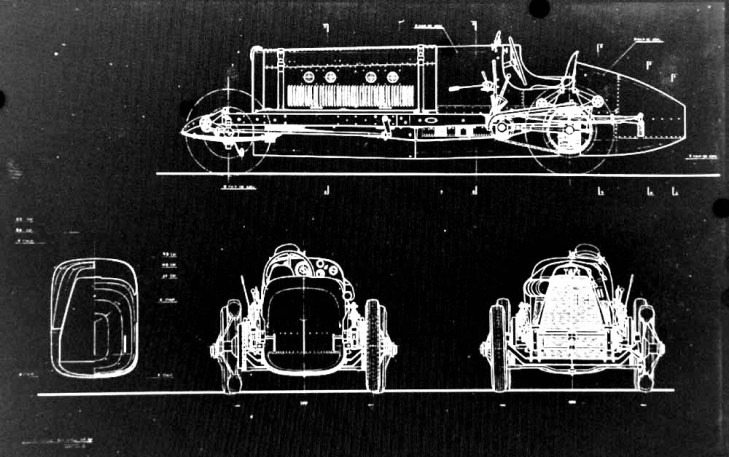 Immagine: disegni della FIAT Mefistofele. Autore sconosciuto. – Image: drawings of the FIAT Mefistofele. Author unknown.
Immagine: disegni della FIAT Mefistofele. Autore sconosciuto. – Image: drawings of the FIAT Mefistofele. Author unknown.
Il suo primato ebbe però vita breve, in quanto il team di René Thomas contestò immediatamente il fatto che la FIAT era priva di retromarcia, prevista invece dal regolamento. Il record quindi non venne considerato valido. A questo punto Eldridge volò a Parigi per svolgere alcune commissioni, mentre Thomas, tornato in pista il giorno dopo, riuscì a conquistare in modo ufficiale un nuovo record sul chilometro lanciato, con una velocità di 143,31 mph. L’auto di Thomas con un ritorno trionfale a Parigi, venne esposta con grande orgoglio nello showroom Delage, lungo gli Champs Elysées. Il 12 luglio, Eldridge di ritorno ad Arpajon, apportò alcune modifiche alla Mefistofele, che grazie ad alcuni misteriosi meccanismi, (il cui funzionamento rimarrà per sempre un mistero, dal momento che oggi non sono più presenti sull’auto esposta), era in grado a questo punto di compiere una rudimentale retromarcia. Tornato con il suo inseparabile meccanico John Ames, in Route d’Orléans “la strada dei record”, strappò il record alla Delage, con una Mefistofele più veloce che mai, raggiungendo 146,01 mph. La leggenda narra che mentre Thomas stava seduto orgogliosamente sulla sua Delage nello showroom di Parigi, Sir Eldridge arrivò davanti al negozio, parcheggiò di traverso la sua Mefistofele e scese dall’auto vantandosi davanti a tutti della conquista del nuovo record ottenuto. Questa fu l’ultima volta che una via pubblica venne utilizzata per un record di velocità. La mitica Route d’Orléans giace ora sepolta sotto ad un’autostrada.
Immagine: la FIAT Mefistofele esposta al Centro Storico Fiat (Archivio e Centro Storico Fiat – FCA Group) – Image: FIAT Mefistofele at the Historic Fiat (Fiat and historic Archive – FCA Group).
La FIAT NB-4 Mefistofele è oggi esposta all’Archivio Storico FIAT di Torino. Durante le fasi di restauro, il colore nero originale è stato sostituito con il rosso (diabolico) ufficiale delle auto da corsa italiane. Pochi mesi dopo, il 25 settembre 1924, a Pendine Sands nel Galles, l’inglese Malcom Campbell, batté il record di Eldridge, al volante di una Sunbeam 350 “Blue bird”, con una velocità di 146,16 mph.
VP – Soulcarsrace
Un particolare ringraziamento ad Alberta Simonis (Archivio e Centro Storico Fiat – FCA Group), per la gentile concessione delle immagini dell’Archivio Storico Fiat.
Note
[1] Felice Nazzaro fu prima pilota collaudatore presso la FIAT al fianco di Vincenzo Lancia, poi imprenditore automobilistico con la Nazzaro & c.
[2] L’anno successivo sarebbe infatti stato inaugurato il circuito de la Sarthe, raccordando alcune strade che correvano attorno alla città ed istituendo il famoso appuntamento annuale della 24 Ore di Le Mans. Solo due anni dopo, nel 1924, Duff assieme al pilota britannico Frank Clement alla guida di una Bentley 3 litri, fecero conquistare a Bentley il primo successo. Battendo dopo 120 giri due Lorraine-Dietrich oramai prossime alla vittoria.
[3] René Thomas: fu vincitore della 500 miglia di Indianapolis nel 1914 a bordo di una Delage
[4] Il nome si ispirava al personaggio diabolico del “Faust”, poema del 1808, scritto dal poeta tedesco Johann Wolfgang von Goethe.
[5] Ma chi era Ernest Eldridge? Si sa molto poco di Sir Eldridge e della su afamiglia. Le poche tracce storiche giunte fino a noi, dicono che Ernest nacque da una famiglia benestante di Hampstead, London. Il padre riscuoteva debiti per conto terzi, o qualcosa di simile e con tale professione riusc= a mettere da parte una certa fortuna. Il figlio Ernest abbandon; la scuola al sesto anno per arruolarsi sul fronte occidentale, dove pare guidasse un ambulanza. Voci non confermate, dicono che avesse volato con il Conte Louis Zborowski, che meriterebbe un articolo a parte, in quanto fu un altro personaggio molto particolare. Costruttore e pilota di auto da record, conquistò il record di velocità terrestre nel 1927, ispirando lo scrittore Ian Fleming (autore della serie 007), che ne trasse un romanzo, da cui venne poi tratto il divertente film musicale “Citty Citty Bang Bang” del 1968. Ma torniamo ad Eldridge, la sua prima apparizione motoristica fu a Brooklands nel 1921, con una Isotta Fraschini con la quale superò le 90 mph di velocità. L’anno successivo apparve con la sua mostruosa Isotta-Maybach da 20.500 cc., con la quale vinse la sua prima gara, superando le 101 mph. Passò poi ad una FIAT da corsa da 10 litri, che guidò riscuotendo dei buoni risultati e vincendo la Gold Cup a Brooklands nell’aprile del 1923. Nel 1925, dopo le prodezze compiute ad Arpajon, decise di vendere la mitica Mefistofele ad un pilota conosciuto con il soprannome “Le champion”, per dedicarsi ad avviare un proprio team, con auto da lui stesso progettate e realizzate con il nome di Eldridge Specials. Partecipò a diverse gare tra il 1925 e il 1926, tra cui la indy 500 del 1926. Tornato in Europa, durante un ulteriore tentativo di record, a causa di un incidente riportò gravi ferite alla testa, che gli costarono la perdita di un occhio. Una volta ristabilitosi, continuò la sua “caccia di record”, conquistando tra gli altri uno a Montlhery con una Chrysler. Fu dopo essere stato a Bonneville per “sorvegliare” i tentativi di record di velocità da parte del Capitano George Eyston, che prese una polmonite che mise fine alla sua incredibile carriera. Sir Ernest A.D. Eldridge aveva 40 anni. (18 luglio 1897 – 27 ottobre 1937).
Embed from Getty Images
Immagine: Aprile 1923, EAD Eldridge al volante della Fiat dopo aver vinto la Brooklands Founders Gold Cup.(Foto di Edward G. Malindine/Topical ufficio stampa/Getty Images) – Image: April 1923, EAD Eldridge sits in his Fiat racing car after winning the Brooklands Founders Gold Cup at Brooklands race track. (Photo by Edward G. Malindine/Topical Press Agency/Getty Images)
Embed from Getty Images
Immagine: 1924, la Sunbeam 350 “Blue bird” di Malcom Campbell- (Immagini ISC & archivi su GettyImages) – Image: the 1924 Sunbeam 350 “Blue bird” of Malcolm Campbell – (Photo by ISC Images & Archives via Getty Images)
Embed from Getty Images
Immagine: settembre 1924, Malcolm Campbell (1885–1948) nella sua Sunbeam 350 “Blue bird” durante le prove di velocità a Pendine Sands. (Foto di Marco/topicoUfficio Stampa/Getty Images) – Image: September 1924, Malcolm Campbell (1885 – 1948) in his 350 hp ‘Sunbeam’ during speed trials at Pendine Sands. (Photo by MacGregor/Topical Press Agency/Getty Images)
Embed from Getty Images
Immagine: 24 agosto 1937, la Thunderbolt del Capitano G.E.T. Eyston nelle fasi costruttive a Wolverhampton. (Foto di David Savill/topico Ufficio Stampa/GettyImages) – Image: 24th August 1937, Captain G.E.T. Eyston’s Thunderbolt racing car being constructed in Wolverhampton. (Photo by David Savill/Topical Press Agency/Getty Images)
YOUTUBE LINK:
POST IN ENGLISH VERSION
The black devil that horrified France. History of the FIAT Mefistofele
The way in which the FIAT Mefistofele was born, represents very well the desire to defy the future typical of the early decades of the century. A challenge full of creativity, pioneering trials, speed, danger often underestimated or not at all assessed and lots of dust swallowed. This is also the spirit of Soulcarsrace, which in its logo has decided to represent the FIAT Mefistofele.
Prequel: 1908, the Brooklands circuit
Before I tell you the story of the Mephistopheles, we need to go back to 1903. The Australian driver Selwyn Francis Edge, moved to England, winner in the 1903 of the Gordon Bennett race on a Napier, was launched the following challenge: “No 4 cylinder car is able to beat my Napier!!”. Felice Nazzaro [1], driver and mechanic at FIAT (founded 9 years earlier), had managed to convince the company, that collect this challenge would mean a very big advertising. The place of the competition, it would have been the fast Brooklands circuit, recently completed, which banked curves were designed and calculated to be flown at any speed. The FIAT departed immediately with the study of the car, given that there were only 6 months. The result was a 200 HP (but some say 175 HP), in which Nazzaro had inserted an ingenious system to prevent overheating of the tyres, thanks to water jets positioned over the rear wheels.
June 1908, Brooklands circuit. The cars had to complete ten laps (about 45 miles). The challenge started: at the start, the Edge’s Napier pulled away from the FIAT of Nazzaro, who after 3 kilometers, with the engine coming at full speed, had already reached. The third lap the Napier broke the engine. Nazzaro’s FIAT kept constant to victory, but in the closing laps a bird crashed, first against the steering wheel then bounced onto the face of Nazzaro, which was running at a speed in excess of 200 surely km/h.For a moment, Nazzaro lost control of his FIAT, which started to skid, but due to his great skills as a driver, managed to keep on track until the end. Cut the finish line victorious at an average speed of 192 km/h. and with his face completely bloodied. Felice Nazzaro was the first man to exceed 200 km/h on a car. 1922, Brooklands circuit 14 years later, the same place. The Canadian driver John Francis Duff, that ran for several years on this circuit with a FIAT S.61, was looking for a car more powerful to compete. Bought a FIAT NB-4 (o SB-4), perhaps the same as Nazzaro, had proceeded to increase further, with aluminium pistons and increasing the compression ratio. During one of the races that were held frequently at Brooklands, probably due to this exasperation in engine upgrade, one of two blocks of the cylinders exploded. Numerous pieces of metal were fired towards the sky, taking with him a portion of the hood and passing close to the head of Duff. Falling back on the track caused one of the biggest disasters ever recorded in the history of motor sport. Duff, miraculously escaped death, abandoned the idea of running with this car, to start a collaboration with Bentley, who had at that time as main aim the competitive entry at Le Mans [2].
Birth of a monster
Sir Ernest A.D.Eldridge [5], was a driver and noble born in London, not new to creating mutations “Frankenstein-style”, born from the coupling between cars and aircraft. The car, (if we can call it), whit which he ran at the time, was an Isotta-Fraschini of 1907, which he had maintained the chassis, and had installed an engine Isotta-Maybach of 20,500 cc. A car which was still a certain effect to people, although it is a time in which people were now accustomed to see traveling vehicles, among the most diverse. Eldridge decided to buy the remains of FIAT NB-4 of Duff, now in disuse after the terrible accident at Brooklands, to face a great challenge: run to beat the land speed record. With the rapid development of the automotive industry, the speed records had become almost an obsession now, both for individuals and for automakers, who for some time now, had sensed that these victories were a very effective advertising promotion. For this purpose, Sir Ernest decided to replace the old FIAT engine, with an engine that had at least the power of Isotta-Maybach which was used to drive on the track. Bought a FIAT A12 engine bis which normally was used on reconnaissance biplanes such as the FIAT R2, the S.I.A 7B1, rather than on Caproni bomber, Ca.46., it was a 6-cylinder engine water cooled, by 21,706 cc. with a capacity of 260 horses. In order to stay on FIAT chassis NB-4, having roughly twice the size of the previous one, Edlridge had to necessarily lengthen the NB-4 frame, and for that purpose took parts of the chassis of a London bus. The chain drive was retained, but decided to make some changes, with 4 valves per cylinder, Magneti Marelli candles, two carburettors and thus increasing power up to 320 HP, 1800 rpm with a compression ratio of 5 to 1.
6 July 1924: the challenge for world speed record
Arpajon, a small town 35 kilometers south of Paris. While families went to the sunday mass, the British nobleman Sir Ernest A.D.Eldridge and the French driver René Thomas [3], congregate to compete at Route d ‘Orléans, a narrow, tree-lined street. It’s the day of the battle. Up for grabs is the car title and the world’s fastest man.
The first aboard his FIAT NB-4 completely transformed, the second driving a Delage La Torpille V12. Sir Eldridge, in keeping with the spirit of the time, loved the challenges pioneering innovative technical solutions and often extreme. Eager to win at all costs, created n amazing device, so brilliant as dangerous: he decided to connect to the biplane engine, a hand pump that would serve to maintain a constant fuel pressure input and an oxygen cylinder, which opened at the appropriate time, it would increase the combustion. A cross between a turbo compressor and a locomotive. Eldridge at the right time, in the midst of the uproar, should yell the power command to his mechanic John Ames, sitting at his side. The cars were a mile long path Route d ‘Orléans, then reverse the direction and go straight back again, in the opposite direction. The race started. The cars speeding by on the narrow road, lined with trees. We do not know who set off first, but what is certain is that the passage of the NB-4 of Eldridge, was like a hurricane, suddenly appeared among the trees. The citizens of Arpajon, terrified at the sight of this spooky black figure, preceded by a deafening roar, that spat fire and smoke from the exhaust pipes, the they named “Mefistofele” [4]. Eldridge and his mechanic John Ames, protected only by hats and heavy wool sweaters, faced no challenge intrepid treating of endless dangers lurking: how the drilling of a tire, which as roads frequently occurred, rather than the explosion of the device connected to the motor, or the sudden appearance of some agricultural vehicle, that could cross the street at that very moment. The car also was equipped with only rear brakes, that acted directly on the differential made his arrest difficult, while the front ones, perhaps in order to lighten it, had been deleted… A French journalist described the Mephistopheles: “.. .a terrifying forces of past vision, that snaking from one side of the street to another, could be governed only by a driver with considerable physical strength…”. Eldridge, who until the last not raised his foot off the pedal, reached a speed of 146.01 mph (234.98km/h), beating the Delage of Thomas and conquering the land speed record. His primacy was short-lived, as the team of René Thomas disputed the fact that FIAT had no reverse gear, provided for by regulation. The record then was not considered valid.
At this point, Eldridge flew to Paris to carry out some job commissions, while Thomas, back on track the next day, he managed to conquer so a new official record over speed mile, with 143.31 mph. Thomas’s car with a triumphant return to Paris, he exhibited with great pride in the showroom Delage, along the Champs Elysees. On July 12, Eldridge back to Arpajon, made some changes to Mephistopheles, that thanks to some mysterious mechanisms, (whose operation will forever remain a mystery, since today are no longer present on the car), he was able at this point to make a rudimentary reversing. Back with his inseparable mechanic John Ames, at Route d’Orléans “the record route”, tore the record to Delage, with Mephistopheles faster than ever, reaching 146.01mph.
Legend has it that while Thomas was sitting proudly on his Delage showroom in Paris, Sir Eldridge arrived in front of the shop, parked crosswise his Mephistopheles and descended from the drive bragging in front of all, the conquest of the new record achieved. This was the last time a public road was used for a record speed. The legendary Route d ‘Orléans is now buried beneath a motorway. NB-4 FIAT Mephistopheles is now exposed to FIAT historical archive in of Turin.During restoration, the original black color was replaced with red (devil) officer of the Italian racing cars. A few months later, on September 25, 1924, at Pendine Sands in Wales, Englishman Malcolm Campbell, broke the record of Eldridge, driving a Sunbeam 350 “Blue bird”, with a speed of 146.16 mph.
A special thank you to Alberta Simonis (Archives and historic Fiat– FCA Group) for the courtesy of the images.
VP – Soulcarsrace
Notes
[1] Felice Nazzaro was first pilot at FIAT along with Vincenzo Lancia, then automobile entrepreneur with Nazzaro & c.
[2]The following year it opened the Circuit de la Sarthe, linking some roads running around the city and establishing the famous annual event of the 24 hours of Le Mans. Only two years later, in 1924, Duff along with British driver Frank Clement driving a Bentley 3 litre, did win a Bentley the first success. Beating after 120 laps two Lorraine-Dietrich now coming to victory.
[3] René Thomas, was winner of the Indianapolis 500 in 1914 aboard a Delage.
[4] The name was inspired to the diabolical character of Faust, 1808 poem written by the German poet Johann Wolfgang von Goethe.
[5] Who was Ernest Eldridge? Very little is known of Sir Eldridge and on his family. The few historical traces have survived, they say that Ernest was born into a wealthy family in Hampstead, London. His father collected debts on behalf of third parties, or something like that, and with this profession was able to put aside a certain amount of luck. His son Ernest left school in the sixth year to enlist on the Western front, where maybe drove an ambulance. Unconfirmed reports say he had flown with count Louis Zborowski, who deserves a separate article, as was another very special character. Manufacturer and car driver record, conquered the land speed record in 1927, inspiring the writer Ian Fleming (author of the 007 series), which was a novel, from which it was taken the funny movie musical “Chitty Chitty Bang Bang” of 1968. But back to Eldridge, his first appearance was racing at Brooklands in 1921, with a Isotta Fraschini which surpassed the 90 mph speed. The following year he appeared with his monstrous Isotta-Maybach from 20,500 cc., with whom he won his first race, surpassing the 101 mph. Then passed to a FIAT 10 litres racing, who led with good results and winning the Gold Cup at Brooklands in April 1923. In 1925, after the feats accomplished at Arpajon, decided to sell the mythical Mephistopheles to a driver who is known by the nickname “Le champion”, to devote himself to start its own team, with cars he designed and manufactured “The Eldridge Specials”. He participated in several races between1925 and 1926, including the Indy 500 of 1926. Back in Europe, during a record attempt, due to an accident sustained serious head injuries, which cost the loss of an eye. Once recovered, he continued his “hunt for record”, winning among others one at Montlhery with a Chrysler. It was after being at Bonneville to “supervise” the land speed record attempts by Captain George Eyston, Eldridge took a pneumonia that put an end to his incredible career. Sir Ernest A.D.Eldridge had 40 years. (July 18, 1897 – October 27, 1937)
Bibliographic sources:
– Article by: Ross Finlay, Mick Walsh and Jon Crooke
– NOVANT’ANNI FA NASCEVA LA NAZZARO – Donatella Biffignandi (documentation center of the National Automobile Museum of Turin)
– 2001- FIAT “A century of Italian car” – vol.I – Quattroruote editions -2010
